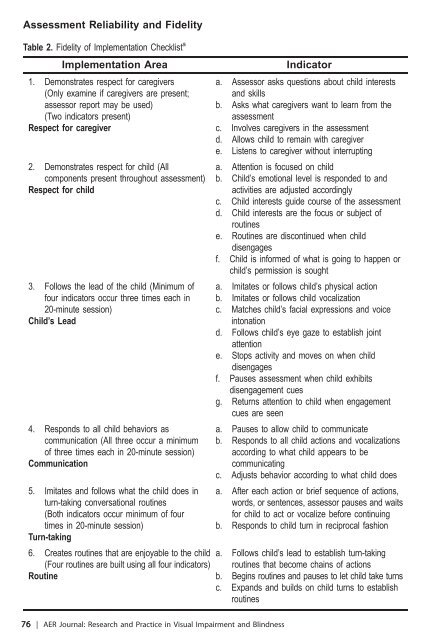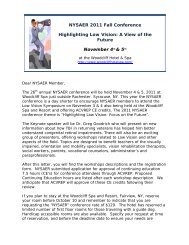Association for Education and Rehabilitation of the ... - AER Online
Association for Education and Rehabilitation of the ... - AER Online
Association for Education and Rehabilitation of the ... - AER Online
You also want an ePaper? Increase the reach of your titles
YUMPU automatically turns print PDFs into web optimized ePapers that Google loves.
Assessment Reliability <strong>and</strong> Fidelity<br />
Table 2. Fidelity <strong>of</strong> Implementation Checklist a<br />
Implementation Area Indicator<br />
1. Demonstrates respect <strong>for</strong> caregivers<br />
(Only examine if caregivers are present;<br />
assessor report may be used)<br />
(Two indicators present)<br />
Respect <strong>for</strong> caregiver<br />
2. Demonstrates respect <strong>for</strong> child (All<br />
components present throughout assessment)<br />
Respect <strong>for</strong> child<br />
3. Follows <strong>the</strong> lead <strong>of</strong> <strong>the</strong> child (Minimum <strong>of</strong><br />
four indicators occur three times each in<br />
20-minute session)<br />
Child’s Lead<br />
4. Responds to all child behaviors as<br />
communication (All three occur a minimum<br />
<strong>of</strong> three times each in 20-minute session)<br />
Communication<br />
5. Imitates <strong>and</strong> follows what <strong>the</strong> child does in<br />
turn-taking conversational routines<br />
(Both indicators occur minimum <strong>of</strong> four<br />
times in 20-minute session)<br />
Turn-taking<br />
6. Creates routines that are enjoyable to <strong>the</strong> child<br />
(Four routines are built using all four indicators)<br />
a. Assessor asks questions about child interests<br />
<strong>and</strong> skills<br />
b. Asks what caregivers want to learn from <strong>the</strong><br />
assessment<br />
c. Involves caregivers in <strong>the</strong> assessment<br />
d. Allows child to remain with caregiver<br />
e. Listens to caregiver without interrupting<br />
a. Attention is focused on child<br />
b. Child’s emotional level is responded to <strong>and</strong><br />
activities are adjusted accordingly<br />
c. Child interests guide course <strong>of</strong> <strong>the</strong> assessment<br />
d. Child interests are <strong>the</strong> focus or subject <strong>of</strong><br />
routines<br />
e. Routines are discontinued when child<br />
disengages<br />
f. Child is in<strong>for</strong>med <strong>of</strong> what is going to happen or<br />
child’s permission is sought<br />
a. Imitates or follows child’s physical action<br />
b. Imitates or follows child vocalization<br />
c. Matches child’s facial expressions <strong>and</strong> voice<br />
intonation<br />
d. Follows child’s eye gaze to establish joint<br />
attention<br />
e. Stops activity <strong>and</strong> moves on when child<br />
disengages<br />
f. Pauses assessment when child exhibits<br />
disengagement cues<br />
g. Returns attention to child when engagement<br />
cues are seen<br />
a. Pauses to allow child to communicate<br />
b. Responds to all child actions <strong>and</strong> vocalizations<br />
according to what child appears to be<br />
communicating<br />
c. Adjusts behavior according to what child does<br />
a. After each action or brief sequence <strong>of</strong> actions,<br />
words, or sentences, assessor pauses <strong>and</strong> waits<br />
<strong>for</strong> child to act or vocalize be<strong>for</strong>e continuing<br />
b. Responds to child turn in reciprocal fashion<br />
a. Follows child’s lead to establish turn-taking<br />
routines that become chains <strong>of</strong> actions<br />
Routine b. Begins routines <strong>and</strong> pauses to let child take turns<br />
c. Exp<strong>and</strong>s <strong>and</strong> builds on child turns to establish<br />
routines<br />
76 | <strong>AER</strong> Journal: Research <strong>and</strong> Practice in Visual Impairment <strong>and</strong> Blindness







